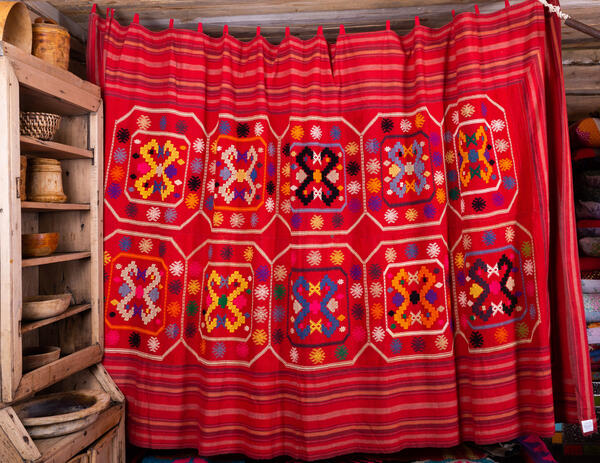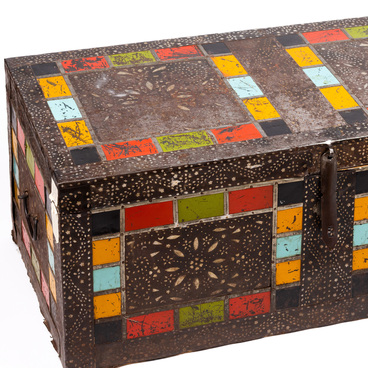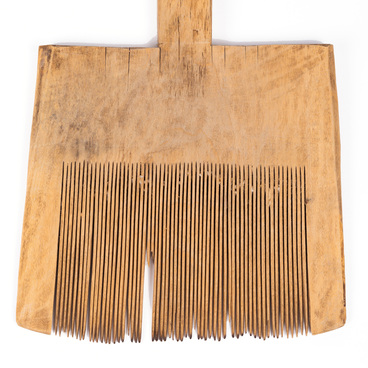The Bashkir cultural traditions of organizing household life were distinguished by one important feature: the traditional dwelling was divided into male and female parts. Due to this process of separating the dwelling, the male part was considered to be the part to host guests, and the women’s was seen as the part for household chores. It was customary to hang an especially elegant, patterned curtain between them; this was called a sharshau.
These curtains were sewn, generally speaking, from factory cotton or homespun fabric. The color schemes mainly used red shades in the weaving warp — this is the kind of curtain that is showcased in the museum’s exposition. Less frequently, a white weaving warp was used. As a rule, these curtains were sewn together from separate strips of fabric, making sure to adjust the pattern’s components so that it resulted in a symmetrical pattern. A woven border was often run along the edge of the sharshau.
The place where the curtain was attached was a transverse ceiling rail, along which it was stretched. The sharshau was straightened out along its entire length, closing the space from the front wall to the door in order to hide the women’s household chore portion of the dwelling from prying eyes. The guests, sitting on bunks, were given the opportunity to properly examine the patterns on the curtain, and appreciate its artistic design. The composition and design of the shashau were intended to attract attention. In the center of the curtain, there was often a central picture that depicted zoomorphic, plant, floral, or geometric designs. Patterned weaving allowed the use of a wide variety of artistic techniques, and using embroidery and applique was also acceptable. When unfolded, the curtain significantly exceeded a person’s height, and was more than 3.5 m long.
The sharshau was traditionally included in the list of items mandatory for a bridal dowry. Often a curtain like this was given as a gift to newlyweds during the wedding ceremony. This kind of gift gained the greatest popularity among the peoples in Central Asia involved in cattle breeding. Bashkir curtains are set apart by the fact that on them the central ornamentation completely occupies the fabric’s entire field, and is enclosed in a border made from a wide strip. Several rows of small rosettes were often scattered along the border of Bashkir sharshaus. In the central field, a variety of ways to arrange the patterns can be observed: squares, polygons, medallions, large rosettes, or nests.
These curtains were sewn, generally speaking, from factory cotton or homespun fabric. The color schemes mainly used red shades in the weaving warp — this is the kind of curtain that is showcased in the museum’s exposition. Less frequently, a white weaving warp was used. As a rule, these curtains were sewn together from separate strips of fabric, making sure to adjust the pattern’s components so that it resulted in a symmetrical pattern. A woven border was often run along the edge of the sharshau.
The place where the curtain was attached was a transverse ceiling rail, along which it was stretched. The sharshau was straightened out along its entire length, closing the space from the front wall to the door in order to hide the women’s household chore portion of the dwelling from prying eyes. The guests, sitting on bunks, were given the opportunity to properly examine the patterns on the curtain, and appreciate its artistic design. The composition and design of the shashau were intended to attract attention. In the center of the curtain, there was often a central picture that depicted zoomorphic, plant, floral, or geometric designs. Patterned weaving allowed the use of a wide variety of artistic techniques, and using embroidery and applique was also acceptable. When unfolded, the curtain significantly exceeded a person’s height, and was more than 3.5 m long.
The sharshau was traditionally included in the list of items mandatory for a bridal dowry. Often a curtain like this was given as a gift to newlyweds during the wedding ceremony. This kind of gift gained the greatest popularity among the peoples in Central Asia involved in cattle breeding. Bashkir curtains are set apart by the fact that on them the central ornamentation completely occupies the fabric’s entire field, and is enclosed in a border made from a wide strip. Several rows of small rosettes were often scattered along the border of Bashkir sharshaus. In the central field, a variety of ways to arrange the patterns can be observed: squares, polygons, medallions, large rosettes, or nests.



